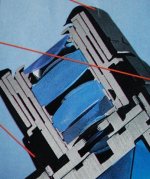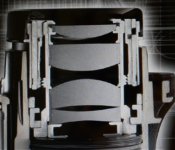Brock,
I refer you to your post #23, partially quoted above. I added the boldface and included the post # so if anybody is so inclined they can reread the whole post. Quoting the whole thing seems a waste of bandwidth.

.
If that is not enough I quote you from another post (#20) in this thread... "For CA non-immunies (which are in the majority), the Premiers could use ED glass".
If this post doesn't say that a majority of users don't see CA, and if you are not presenting that as a fact, then you'll have to forgive me. I'm wondering if you are angling toward a gig as a political speech writer where your politician is bound by the mores of the profession into saying things like "I never said that!". Now, I'm not trying to diss you or start an argument here, but I think it needs to be pointed out that it seems you are stretching reality quite a ways too far here, without some more supporting evidence that CA is something seen by most users, I say not... until somebody can actually prove otherwise.
Steve,
By partially quoting me and bold facing portions of your choosing, you not only took what I wrote out of context but skewed its meaning to your own ends (hey, but you saved bandwidth!

.
Here's what I wrote with my own boldface to show
my emphasis:
"What "the majority of binocular users are not immune to CA" means is that unlike you, most users do see CA.
The point was to distinguish it from "rolling ball," which most users don't see or quickly adapt.
The purpose of that distinction being that Nikon could leave the "rolling ball" and take the cannoli, I mean CA, away.
I don't think anybody likes CA ("Yeah, I just love it, give me some more!"), but how bothered they are by it in any particular bin is another matter, as you indicated with your suggested statistical survey (maybe Nikon will use it in the focus groups to test market a Premier ED)."
The point of the post you quoted, which was in reply to Bob's implied question about what I meant, was simply to distinguish two issues in the HG/Premier series, not to wage a campaign against those who don't see CA or who aren't bothered by it.
Here's a question for you. If so many people don't see CA then why are ED bins selling like hotcakes? And why are the Big Three and Nikon putting ED and FL glass in their top bins? Would they do this if only the
minority of birders can see CA? Doh.
Binoculars are achromats. They display CA. Most people see it in high contrast situations. A few never see CA in any situation, but that is rare. How do I know? Did I survey birders in the field like David didn't? No, birders are looking for birds, they aren't going to talk about CA or SA aberration of the exit pupil or "rolling ball" or pincushion.
Optics junkies, OTOH, like to nitpick optics and do talk about these issue
ad nauseam. A quick browse through these forums will easily demonstrate that. The last half dozen posts on this thread alone will demonstrate that.
Very few people have written here or on the other bin forums I read that they wouldn't know CA if it hit them between the eyes, but there are some. Even an alleged immunie like Bob admitted to seeing CA in the Pentax 9x25 in high contrast situations.
Do you see CA in bins yourself? Never? If so, then you are the exception rather than the rule. Do we need to do TWO polls now? One to find out the obvious, that non-ED bins display CA and that a majority of users see it in high contrast situations?
No. I won't bother wasting my time with something that obvious and trivial. It would be like surveying BF members to ask them what color the sky is.
The other question that Bob troubled, that is, whether or not people see a higher than average amount of CA in the HGL/Premier series is a legitimate one.
Being someone who sees more than average CA in that bin, I would naturally focus on such posts that agree with my opinion whereas Bob, who doesn't think it has more than average CA (and he uses a 10x32 LXL, which is probably the worst CA offender in that series!) wouldn't pay as close attention to the same issue on various forums or in reviews.
So we could both be suffering from selective memory. I don't think I am, but I will give him the benefit of the doubt because I am not infallible.
The important caveat to keep in mind, which I mentioned earlier, is that people on forums such as these are not your typical birders (I hope like David, you're not going to dispute that too). They are for the most part optics junkies except those occasional visitors who stop in once or twice to ask for advice on which bins to buy and then disappear.
Would we even be having this picayune discussion if that weren't true?
Ipso facto, optics junkies are more likely to LOOK for CA and other aberrations (including the Emperor's) and also know more about them than David's birding buddies who are focusing exclusively on the birds not the optics.
And if those birders had seen something obviously bothersome about the birding bins they bought, they would have sent them back or sold them and not be using them in the field. So they've already vetted their optics.
However, even then, if someone who was an optics junkie, had them to look at a crow against a high contrast, bright gray sky and move the bird slightly off center (in their non-ED bins) and asked if they see any color fringing around the silhouette of the bird, I'd bet most of them would say, "Yes."
Then nonplussed quickly go back to looking for an ivory-billed woodpecker or whatever it is they are trying to add to their life lists.
But... as Steve Ingraham had warned, once you go looking for CA, you might start to see it more often than you used to. So some of those birders might start to see CA which they were previously able to either ignore or at least not be bothered by.
So when you call attention to something you heighten your awareness of it. I'm sure Ed knows the technical term for that.
This my last post on the subject. I'll leave the last word to you and to those interested in reading it.

Brock






